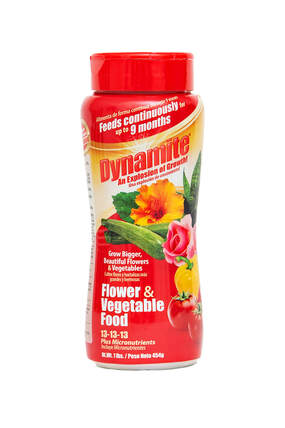FLOWERS & VEGETABLES 13-13-13

Looking for an explosion of growth? Dynamite Flower & Vegetable Plant Food is perfect for all flowering shrubs, trees, landscape plants, foliage, houseplants, ferns, palms, grasses and herbs. It contains balanced rates of NPK + micro-nutrients to aid in the establishment of roots, strong stems and branches, greener foliage and more blooms.
• Feeds continuously up to 9 months
• Nutrients won’t wash out with heavy rains or irrigation
• Available in 1 and 2 pound bottles with a convenient shaker lid
• Feeds continuously up to 9 months
• Nutrients won’t wash out with heavy rains or irrigation
• Available in 1 and 2 pound bottles with a convenient shaker lid
Suggested Application
New In-Ground Plantings:
1. Shake Dynamite Plant Food into prepared hole near the roots.
2. Fill in with soil.
3. Water thoroughly and as often as needed.
Existing In-Ground Plantings:
1. For each 3 square feet of garden area, sprinkle 4 capfuls, the equivalent of 6 Tbsp, onto the soil around each plant.
2. Lightly mix the plant food into the top inch of soil.
3. Water thoroughly and as often as needed.
Existing Container Plantings:
1. Sprinkle and mix into top inch of soil using the table below for application rates.
2. Water thoroughly and as often as needed.
New Container Plantings:
Sprinkle into the prepared hole before planting using the application table below for amounts.
For all plantings, reapply every 9 months during the growing season and water regularly.
New In-Ground Plantings:
1. Shake Dynamite Plant Food into prepared hole near the roots.
2. Fill in with soil.
3. Water thoroughly and as often as needed.
Existing In-Ground Plantings:
1. For each 3 square feet of garden area, sprinkle 4 capfuls, the equivalent of 6 Tbsp, onto the soil around each plant.
2. Lightly mix the plant food into the top inch of soil.
3. Water thoroughly and as often as needed.
Existing Container Plantings:
1. Sprinkle and mix into top inch of soil using the table below for application rates.
2. Water thoroughly and as often as needed.
New Container Plantings:
Sprinkle into the prepared hole before planting using the application table below for amounts.
For all plantings, reapply every 9 months during the growing season and water regularly.
Pot Size |
Application Rate Tbsp (Tablespoon) |
Capful |
4-4.5" |
1/2 Tbsp |
1/3 Capful |
6"-1 Gallon |
1 1/3 Tbsp |
2/3 Capful |
3 Gallon |
2 1/3 Tbsp |
1 1/3 Capful |
5 Gallon |
3 2/3 Tbsp |
1 2/3 Capful |
Broadcast Rate |
2 Tbsp. per square foot |
Is Your Plant Hungry? When to Reapply.
Your plant will start to show signs of stress if it isn’t getting the nutrients it needs. Tell-tale signs include: the color of the leaves are yellowing or turning a lighter shade of green, there’s a reduced number of blooms on a flowering plant, or there’s slower than usual growth. If you’ve been watering regularly, and there aren’t signs of insects or disease on the plant, chances are your plant needs to be fed!
Your plant will start to show signs of stress if it isn’t getting the nutrients it needs. Tell-tale signs include: the color of the leaves are yellowing or turning a lighter shade of green, there’s a reduced number of blooms on a flowering plant, or there’s slower than usual growth. If you’ve been watering regularly, and there aren’t signs of insects or disease on the plant, chances are your plant needs to be fed!
